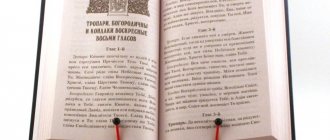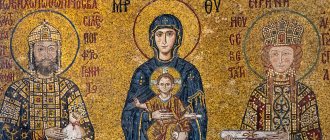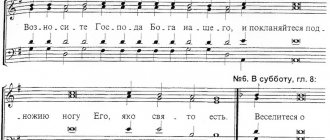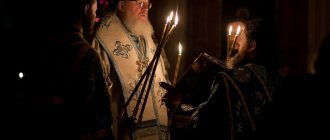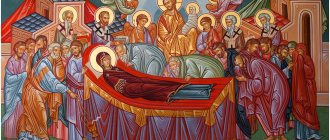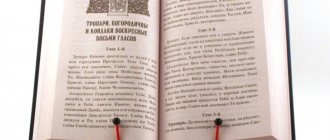Coming to an Orthodox church for the first time, many ask the question: what are troparia? The word “troparion” translated from Greek means “mode, melody, tone.” It, like many others, entered the church life of the Russian people. By and large, it can be identified with a hymn, that is, with a short chant, which contains the whole main meaning of the Christian holiday.
Or, if a holiday is dedicated to a saint, then the troparion concentrates the main events in the life of the righteous person, saint or martyr. Often in the chants there are appeals to the saint, his exploits are revealed, and so on. Let us take a closer look at what troparion, kontakion, canon and other names are in Church Slavonic.
Easter troparia
The troparion often complements the kontakion. Kontakion is like its continuation, which reveals this topic even deeper. For example, if in the festive Easter troparion it is sung about the resurrection of Christ, “Christ is risen from the dead, trampling down death by death and giving life to those who are in the tombs!” said “Rejoice!”, to the apostles “grant peace, grant resurrection to the fallen!”
Church-goers probably heard something like the following exclamation at the evening service: “Voice one. Lord, I have called to You, hear me.” Then the singers begin to perform melodic tunes, which are called stichera. And according to the rules, Vespers ends again with a troparion or a troparion voice, of which there are only eight.
Prayer for financial prosperity
These words will be most effective on the day of Holy Epiphany. The text of this prayer has been verified by the long years of history of our ancestors:
"God! Behold, I am Your vessel: fill me with the gifts of Your Holy Spirit, without You I am empty of all good, or even more so, full of all sin. God! Behold, Thy ship I am: fill me with a load of good deeds. God! Behold Your ark: fill it not with the charm of love of money and sweets, but with love for You and for Your animated image - man.”
Differences between troparia and other hymns
What are troparia, how to distinguish troparary voices from sticherny, irmos? When they first come to the choir, the singers do not understand the meaning of these chants. In fact, the troparia are the highest of all church works. They can only be rivaled by the prokeme, which are performed before the reading of the Apostle and the Gospel.
Therefore, troparia, together with kontakia, take pride of place among other chants. The troparia opens and ends Matins and Vespers.
The meaning of the word “troparion” can also be interpreted as “victorious sign”, “trophy”. That is, they glorify the victory, for example, of Jesus Christ over death for all of us, the victory of the martyr over paganism, the saint over the passions, and so on.
For the first time, troparal voices began to be sung in Egypt and Asia Minor. This happened in the 4th and 5th centuries AD. The canons appeared much later - in the 8th century.
Oddly enough, the question of what a troparion is has not yet been settled. The meaning of this word among the ancient Hellenes was explained as “harmony, singing.” All their melodies - Mixolydicean, Lydicean and others - were called troparions.
In the Church Slavonic charter, the word “troparion” is often used with other words-additions, for example, troparion of dismissal. In fact, they are actually the main hymns with which Matins and Vespers end.
History and types of troparions
Photo: Perervinsky-monastery.rf
Troparions are the most ancient chants, which laid the foundation for the entire hymnography of the Christian church. It was these brief stories about events that became significant in the history of Christianity that largely influenced the formation of the entire divine service.
They existed already in the 4th and 5th centuries in the churches of Egypt and in Asia Minor worship. But a Christian reference was found in the Church of Constantinople. There the troparion served as the only hymn of the service. These facts give special significance to such elements of worship, speaking about their significance, inviolability and necessity for Christianity.
It is worth noting that the troparia are not taken from the Holy Scriptures, that is, they are not psalms or biblical songs, which have a more ancient origin.
The melody of the troparion is especially rich and complex, because it is the crown of other tunes, occupying the most honorable place. The Troparion opens a series of chants at Matins, and also serves as the conclusion of prayers at Vespers. During the liturgy, it replaces all other types of chants, as on the clock.
There are three types of short chants:
- Troparion of the holiday. Tells about the essence of the holiday, reveals its meaning and glorifies it.
- Troparion of the icon. Tells about the appearance of an icon, illuminates its meaning.
- Troparion of the Saint. The feast day of each saint has its own troparion, because it is in it that the feat of the saint, his merits and miracles performed during his life are outlined.
Such troparia are called dismissal because they are sung in the final part of the service.
Troparion of the canon
The troparia of the canon are hymns that are sung during the service of the canon. That is, this is the number of stichera that are sung along with small choruses.
If the charter of the liturgical book indicates that “I cried out to the Lord” in such and such a voice, this means that the stichera on “I cried to the Lord” should be sung in a certain voice. In church singing you can also find such names as sedalny, ipakoi, luminary. All these chants are close both in meaning and melody to the troparia. Therefore, they are often combined into one word.
It is necessary to know which syllable is stressed in the word “troparion”. This is the second and the letter A. Since the word was borrowed, it is not surprising that many place emphasis on the letter O. But for those who have been attending church for a long time, keep all its foundations and strive for perfection, it is unacceptable to make mistakes in it.
Entry
Currently, troparia are found in the following places of worship:
Vespers
- Apolytikion
Matins
- Apolytikion (after "God the Lord")
- Sessional hymns (after reading the hymnal)
- Canon
- Session hymns (after the Third Canon)
- Apolytikion (at the end of Matins)
Small watch
- Apolytikion
- (in the Royal Hours special troparia are added to them)
Divine Liturgy
- Beatitudes
- Apolytikion
Varieties of troparia
Let's look at what troparia there are and to whom they are dedicated. It happens that in the service book or calendar there is a short word: “Theotokos.” What does it mean? These are stichera, sedals or troparia of the Mother of God, dedicated to her feat and service.
If the word “Resurrection” is there, it means that all the chants after this word are dedicated to the Resurrection of the Lord Jesus Christ.
The word “Theotokos” is the grief of the Most Holy Theotokos over the death on the cross of her son, Jesus Christ.
“Resurrection of the Cross” - hymns praising the Lord’s suffering on the cross and his resurrection. Such chants are performed after the Resurrection Canon and they are placed in the Octoechos - a special book where all the canons and troparia dedicated to the Resurrection are collected.
The word "Martyr" refers to chants dedicated to martyrs. They can be found both in the Octoechos and in the Triodion and Menaion. To quickly find them, the word “Martyr” is placed before the stichera.
Prayer before swimming in an ice hole
Don't forget to bring a swimsuit or shirt for water procedures, a towel and non-slip slippers. A thermos with a hot drink will also come in handy. No one has canceled everyday care of one’s own body.
Before plunging into the invigorating water, you should read the “Our Father” or say the following words:
“O Most Merciful God, Father, Son and Holy Soul, worshiped and glorified in the inseparable Trinity, look with compassion on Your servant (name), who is overcome by illness; forgive him all his sins; give him healing from his illness; restore his health and bodily strength; Give him a long and prosperous life, Your peaceful and premium blessings, so that together with us he brings grateful prayers to You, the All-Bountiful God and my Creator. Most Holy Theotokos, through Your omnipotent intercession, help me to beg Your Son, my God, for the healing of God’s servant (name). All saints and angels of the Lord, pray to God for His sick servant (name). Amen".
Also, be sure to be baptized and only then plunge into the water.
If you are too afraid of plunging into icy water, it is better not to do it. In any case, everyone will be rewarded according to their faith, and if your faith is strong enough, then even without diving into the hole you will get what you want.
When are troparia for the dead sung?
“Repentance” is a special type of chant where the main theme is confession of one’s own sins before God.
They are also called “touching” in another way. You can find them in Oktoiche at services on Monday and Tuesday. During Great Lent, three penitential troparions are celebrated, the only ones of their kind.
“Dead” and “deceased” are chants that contain prayers for the repose of the deceased. The funeral service and the Octoechos Saturday service contain the text of these prayers.
to the Prophet
Troparion, tone 2
Your prophet ( name
) memory, Lord, celebrating, we pray to You, save our souls.
Kontakion, tone 4
Enlightened by the Spirit, your pure heart of prophecy quickly became your brightest friend: see for what is real, far away; for this reason we honor you, blessed prophet ( name
), nicer.
Greatness
We magnify you, holy prophet of God ( named
), and we honor your holy memory, for you pray for us to Christ our God.
Immaculate
“Troparia for the Immaculates” are hymns that recall how the myrrh-bearing women came to the tomb of the Lord and where they saw an angel and heard from him the happy news of his resurrection from the tomb. They are performed at Matins during the polyeleos.
The word “Immaculate” came into the Church Slavonic language from the 17th kathisma, which opens with the 118th psalm. “Blessed are the blameless on the way...” - this is what is sung in the psalm, and from this name the word “blameless” is strengthened. During the polyeleos, these troparia begin with the words “Blessed are you, Lord” and consist of six parts, each of which is separated by a chorus and exclamations: “Glory to the Father and the Son and the Holy Spirit” and “And now and ever and unto ages of ages. Amen".
On holidays, instead of the “Immaculate Ones,” the troparia “Magnificence” are sung before the icon. They are also performed when funeral services are held for bishops or priests who have earned the love of the people, their parish, and who have become martyrs.
One of the most famous troparions, which has become so widely famous that it has been translated into all languages, is the work “Quiet Light,” which is sung at the All-Night Vigil.
Links
- [commons.wikimedia.org/w/index.php?title=File%3ARumovskiy_novaya_skrizhal.djvu&page=72 Veniamin (Krasnopevkov-Rumovsky) New Tablet part 2. chapter 4. § 9. p. 72]
- [www.canto.ru/index.php?menu=refer&id=tropar Troparion: Evensong
] - [www.pstbi.ccas.ru/institut/book/1997/vac.htm About the most ancient hymns of the Theotokos]
- [www.krotov.info/libr_min/19_t/tau/shev_02.htm#_Toc525174089 Archbishop Averky (Taushev). Liturgics] (chapter on troparia)
- [azbyka.ru/dictionary/18/tropar-all.shtml from the book: Cyprian Kern. Liturgics. Gymnography and eorthology.]
- Troparia of dismissal: [www.liturgy.ru/grafics/chasoslov/page.php?p=270 for the entire week] (inaccessible link from 05/11/2013 (3216 days)); [www.liturgy.ru/grafics/psaltir1/page.php?p=232 8 voices] (inaccessible link from 05/11/2013 (3216 days)); [www.liturgy.ru/grafics/psaltir1/page.php?p=241 weekly] (inaccessible link from 05/11/2013 (3216 days)); [www.liturgy.ru/grafics/psaltir1/page.php?p=243 Mother of God] (inaccessible link from 05/11/2013 (3216 days)); [www.liturgy.ru/grafics/psaltir1/page.php?p=259 Triodion] (inaccessible link since 05/11/2013 (3216 days))
- [www.liturgy.ru/grafics/psaltir1/page.php?p=312 Charter on dismissal troparions and kontakia] (inaccessible link from 05/11/2013 (3216 days))
- [www.liveinternet.ru/users/isolophey/post104951345/ On the history of the troparion “Quiet Light”]
Holidays and weekdays
We figured out what a troparion is. But when is it read? Only in honor of great holidays? Or does a grandiose celebration not be required to perform this type of chant?
This is interesting! History of the Stavropol and Nevinnomyssk Metropolis
Troparions are sung in churches every day, since almost every date in the calendar is significant for a certain sacred event. This could be the birthday, death or glorification of a certain saint, a certain holiday that not every layman knows about, etc.
Therefore, the days when it, that is, the troparion, is sung in church are not even marked on the calendar, because this happens every day. In order to make the troparia more convenient to perform, they decided to divide them depending on the day of the week.
The only exceptions are Sunday hymns, which take place every Sunday, and prayer services in honor of some major holiday.
So, what exactly is sung on each of the existing days of the week?
On Monday, according to church tradition, it is customary to glorify all ethereal representatives of the highest heavenly ranks. As a rule, they pray turning to the heavenly archangels.- Tuesday is the day of glorification of the holy prophets, especially John the Baptist.
- If Wednesday or Friday has come, then it’s time to remember the Savior and his painful death, for the sake of all Christians on Earth. Also, troparia on Wednesdays and Fridays are dedicated to the Life-Giving Cross.
- On Thursday, parishioners honor the memory of St. Nicholas the Wonderworker as the leading saint of all saints. Also, along with him, all existing apostles are glorified.
- Saturday is a day of mourning. Therefore, all the troparia read on Saturdays mourn the holy martyrs.
Interest Ask! When buying prayer books and other collections of church hymns, people ask a completely reasonable question: is it possible to read the troparion at home? The answer to this question is clearly positive, since this prayer is essentially no different from the classical ones, more familiar to ordinary lay people. At home it is forbidden to sing only the Divine Liturgy.
Saint
Troparion, tone 4
The rule of faith and the image of meekness, self-control, teacher, show you to your flock the truth of things; For this reason, you have gained through high humility, rich in poverty, priestly father ( named
), pray to Christ God for the salvation of our souls.
Kontakion, voice 2
Divine thunder, spiritual trumpet, faith to the planter and cutter of heresies, saint of the Trinity, great saint ( named
), with the Angels always standing, pray unceasingly for all of us.
Greatness
We magnify you, holy father ( name
), and we honor your holy memory, for you pray for us to Christ our God.
Standard interpretation
According to Wikipedia, troparion is a term that has ancient Greek origins.
It is translated into Russian as “melody” or “mode”, but its meaning has a slightly different meaning. It can be described as a prayer chant in a short form, which reflects the essence of a particular holiday.
Also, the troparion for prayers glorifies and calls for help the sacred person “responsible” for a specific holiday.
Informative! Schedule of services at the Elokhov Church on Baumanskaya
An interesting fact is that the texts of the troparia and the order of their performance are not indicated in either the Old or New Testaments. The tradition of performing such short, simple and extremely understandable chants arose in Constantinople around the fifth century AD.
Roman the Sweet Singer invented, or rather wrote, the first troparia, and the tradition itself was included in the Charter of the Great Church of Constantinople. Nowadays, every person can learn about what a troparion is and get acquainted with the texts of such chants by purchasing the corresponding collection called “ Troparion ” .
All existing troparia of the day or holiday have the same structure. At the very beginning there is a clear description of the holiday or a notice of the merits and deeds of a particular saint. This is followed by a request in which the parishioners ask the saint to pray for today’s holiday and their souls. Sometimes the singing ends with a doxology.
Note! Despite the fact that such a concept in the church as a troparion has a musical basis, that is, it consists of a musical part and a verbal text, its verses can be unrhymed. It is important that they reflect the essence of the sacred celebration, and in some cases rhyme can be neglected.
Kontakion. What it is?
Surely you came across such a concept as kontakion when you became acquainted with the troparion. How does the term described above differ from kontakion and do they have any similarities?
So, kontakion is also a short prayer, performed in the form of a chant, which describes a particular holiday.
But it differs from the troparion in that it characterizes not the celebration as a whole, but a separate event or tradition that is characteristic of the holiday.
It is important to note that often the troparion is separated from the kontakion by several stanzas. This happens if the second is part of the first, and does not sound as part of the canon.
Important! How the Nativity of St. Nicholas the Wonderworker is celebrated on August 11
Also, a kontakion can be not only part of the troparion, but also a separate stanza of the canon or an independent mini-work.
Reverend
Troparion, tone 4
In you, mother, it is known that you were saved in the same image: having accepted the cross, you followed Christ and in action you taught to despise the flesh, which passes away, but to be diligent about the souls, things more immortal; Likewise, the venerable one will rejoice with the Angels ( named after
), your spirit.
Kontakion, voice 2
For the love of the Lord, O venerable one, you hated the desire for peace, having enlightened your spirit with forgiveness: you mightily conquered the beasts; but through your prayers destroy the enemy’s vacillation.
Greatness
We please you, reverend mother ( name
), and we honor your holy memory: for you pray for us, Christ our God.
Unmercenaries
Troparion, tone 8
Holy saints without money and miracle workers, visit our infirmities: accept it, give it to us.
Kontakion, voice 2
Grace, receiving healings, extending health to those in need, physicians, wonderworkers of glory; But by your visit to the warriors, you will overthrow insolence, healing the world with miracles.
Greatness
We magnify you, wonderworkers of glory ( their names
), and we honor your honest sufferings, which you endured naturally for Christ.
Features of the singing order
Mainly, troparia and kontakia are performed during temple and throne celebrations as part of the divine liturgy. Similarly, these chants are performed on the days of medium, small and polyeleos celebrations.
Informative! When they read the rule of Basil the Great against the desecration of women
During the celebration of Easter, the most important troparion is sung - “Christ is Risen.” The troparion for the Nativity of Christ is performed similarly.
In general, for each holiday, both small and large, chants are performed in a certain sequence.
First, all the troparia are sounded, which fully describe the main event of the day. Then the church choir, together with the parishioners, perform kontakia.
It is important to emphasize that often in churches major holidays are superimposed on the days when one or another troparion should be performed according to the schedule.
In such cases, the daily version is omitted and the prayer that tells of the great celebration is performed.
However, if a service in honor of a holiday takes place in the evening, then in the daytime it is permissible to perform a planned chant, which is sung on one or another day of the week, regardless of the event.
This is interesting! Strong maternal prayer amulet to protect her son
